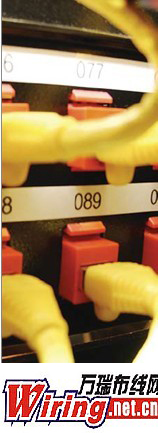|

In the last few years, changes in technology have made their presence felt in virtually every area of business, manufacturing, and daily life. For companies to be successful and meet the consumer’s growing demand for high-tech functionality, they must be able to keep pace with available technology, and they must know how to apply and upgrade that technology costeffectively.
The Importance of the 606A Standard
A key part of maintaining an effective, productive data communications infrastructure is clear, standardized labeling and documentation of all system components, including all horizontal links, backbone cables, faceplates/outlets, and termination hardware. This allows company owners, end users, consultants, contractors, installers, administrators and others to know precisely what components exist in the system, where they are installed, and how they are connected. This information is invaluable when it comes time to upgrade, repair, replace, or move any of your equipment, and can save hours, or even days, when a physical audit of a company’s network investment is needed. Simply knowing which cable leads to what equipment can make a huge difference in productivity – hours saved keeping your system up and running are hours that can be spent doing business, instead of crawling around under a desk wondering which outlet needs repair.
The ANSI/TIA/EIA-606A Administration Standard for Telecommunications Infrastructure, commonly known as the “606A” standard, creates a universal standard for telecommunications cabling systems documentation and labeling. While the standard is not a code, since there are no penalties for non-compliance, it is a best practice that helps companies install and maintain an efficient telecom system that is easier to troubleshoot and faster to upgrade.
Benefits of Labeling to the 606A Standard
The standard is easy to follow, modular, and scalable – so once you are compliant with the standard, any company can expand to higher classes within the standard without changing any existing documentation or labeling. Because the labeling and documentation outlined in the standard are independent of any specific technology, the 606A standard works over the life of your telecommunications system, without regard to changes in technology over time.
Through a consistent labeling and documentation standard, it is possible to know the nature and location of every cable for every workstation in your company. This allows for better system maintenance, through faster and easier installations, upgrades, repairs, and audits. A well-maintained, well-documented telecom system is ultimately more productive and more cost-effective.
Label formats and requirements to meet the standard
The 606A standard calls for a uniform labeling format that indicates the type, location, and purpose of all cables and endpoints, plus color-coding for faster and easier identification of all elements. These labels, in turn, serve as the key to finding additional information included in the documentation.

Heat-shrinkable cable markers can be pre-printed on thermal transfer label printers for print permanence and 606A compliance.
To meet the standard, all labels used should meet these requirements:
• Labels must be easily visible and readable (via size, color, and text contrast);
• Label materials must be resistant to the location’s environmental conditions (including moisture, heat, UV light);
• Labels must have a useful life equal or greater to the component being labeled (this applies to both label adhesion and text readability);
• Label printing must be done by a mechanical device and not handwritten.
The above standards were developed in response to the experience of many installers trying to make upgrades or repairs to systems labeled with standard office labels and/or handwritten labels. Often, what installers find when they open the telecommunications room is a pile of labels on the floor or a bunch of illegible, faded, handwritten labels that serve no purpose. To complicate matters, many systems not complying with the standard are labeling in an idiosyncratic fashion that is intuitive only to the person who originally installed the system. If that person has left the company, the system becomes useless. By applying the standard, your labeling system remains relevant no matter who is installing, upgrading, or repairing the system, and regardless of what technology you may apply to your system in the future.
Innovations in label materials and formats have helped to ensure easy compliance with the standard, through more durable materials that last for the life of the installation, die-cut labels that save time and avoid waste, and industrial-grade adhesives that stick to coated wires and cables.
Some companies try to save some money by purchasing labels and printers at the local office supply store, but later find that any savings achieved were negated when the labels fell off or the text faded within a short time frame. Additionally, standard office printers don’t offer applicationspecific labels, often leading to formatting frustration and material waste.
For these reasons, it is best to use an industrial-grade label printer with application-specific labels. These will deliver durable thermal transfer printing, industry-specific formatting options, and better label durability.
Label materials and standards that are 606A compliant include:
• Self-laminating cable labels – a clear “tail” wraps around the label, protecting the text against abrasion;
• Pre-sized die-cut labels and inserts for faceplates;
• Slide-in strips with user specified pairings and grid lines for 110-blocks;
• Flame-retardant hang tags for labeling cables and cable bundles for public networks.
“Smart CELL” Technology drives newer, simpler label printing systems
Until recently, many label printers used by the datacom industry involved calibrating and formatting labels, and running test labels until the user was certain of the right font size, print mode, and label orientation. The next phase of printer technology offered basic “media recognition” capabilities, allowing the printer to sense what type of label was loaded and format accordingly. Many handheld printers still work this way, and they offer an easy-touse, portable labeling solution for many cable installers.
For those who must print a wider range of label quantities or who want to use more advanced label types for the voice/data industry, new printing systems are now available that offer bi-directional smart cell technology. These printers dramatically cut set-up time and reduce material waste, because the printer recognizes the correct material and ribbon combination, automatically adjusts for material parameters, print speed, and heat settings. Smart cell technology allows users to simply load, click, and print labels quickly and easily – a huge advantage for datacom installers who must label thousands of cables, plus faceplates, outlets, patch panels, 110 blocks, and 66 blocks.
Using “smart” printers in conjunction with labeling software makes it easy and efficient to create labels with standardized formats that meet the 606A standard.
Bringing it all together: Cable Management Software
A major component of a compliant 606A system is documentation. This aspect of the standard provides in-depth information gleaned from the standardized labeling that has been done throughout the installation. Proper documentation allows installers, administrators, and maintenance technicians to know the nature and location of every element within their physical network.
The documentation system may be managed through a paper-based system, through standard spreadsheet software, or with a special-purpose cable management system. While a paper-based or spreadsheet-generated system may offer short-term cost savings, a cable-management system designed for this purpose offers a faster, more complete solution for the long term. If your system is growing, or if you upgrade frequently, then resources spent on a dedicated cable management system will turn quickly into both time and dollar savings.
Integrated cable management and label software systems offer many advantages over other manual or general-purpose documentation and labeling systems:
• Complete documentation saves time in locating and correcting network issues – reducing downtime and increasing productivity;
• A cable management system with label design software will allow you to format and import your data for faster and more accurate label creation and printing;
• Cable management software allows you to label and document your system as one integrated process– for faster, easier, more accurate network documentation;
• Complete, integrated labeling and documentation simplifies the management of your physical network, including audits, updates, and changes;
• A special-purpose cable management system will allow you to build and update your documentation as you go – scaling and expanding as needed.
Whatever labeling and documentation system you choose to use, investigate the latest technology – you may find that investing in an integrated labeling and documentation system will save you time and money in the long run, while delivering reliable, 606A-compliant network documentation that will keep your company more productive and cost-effective.
|